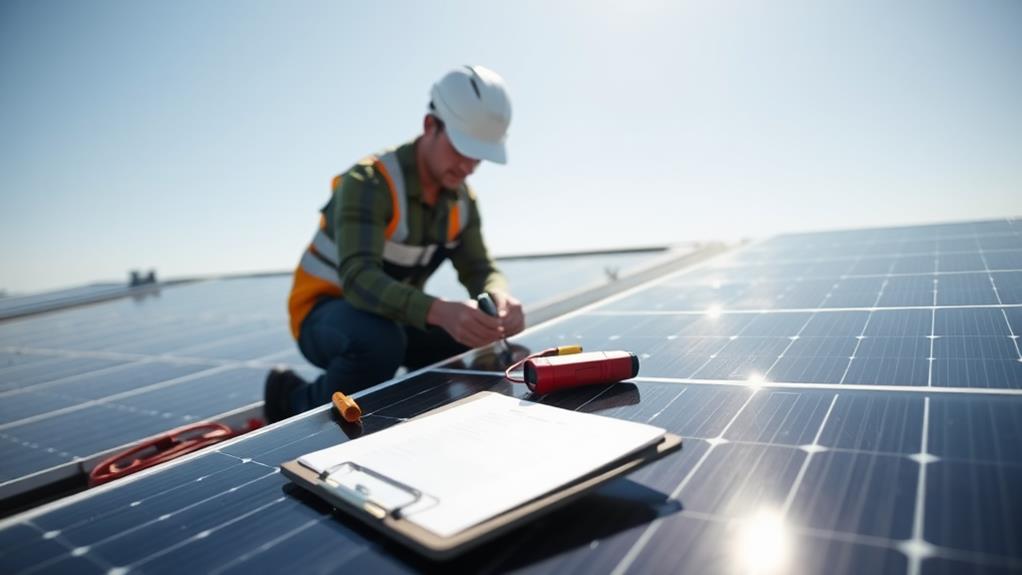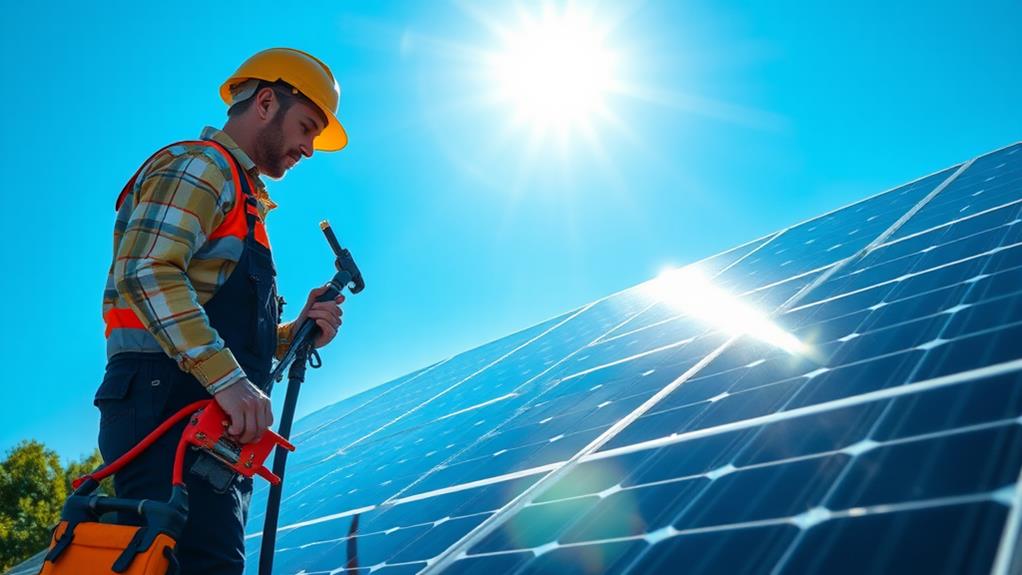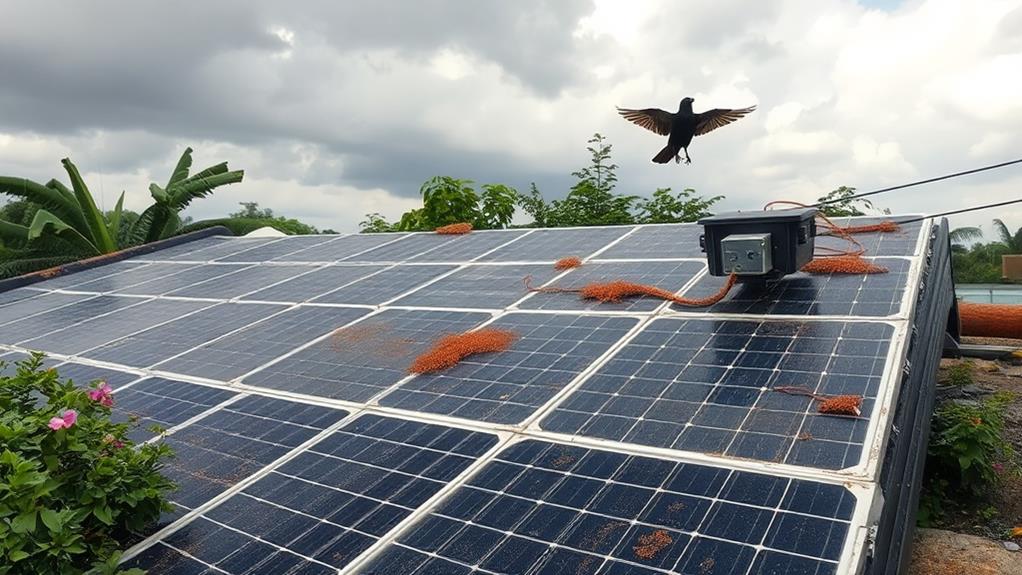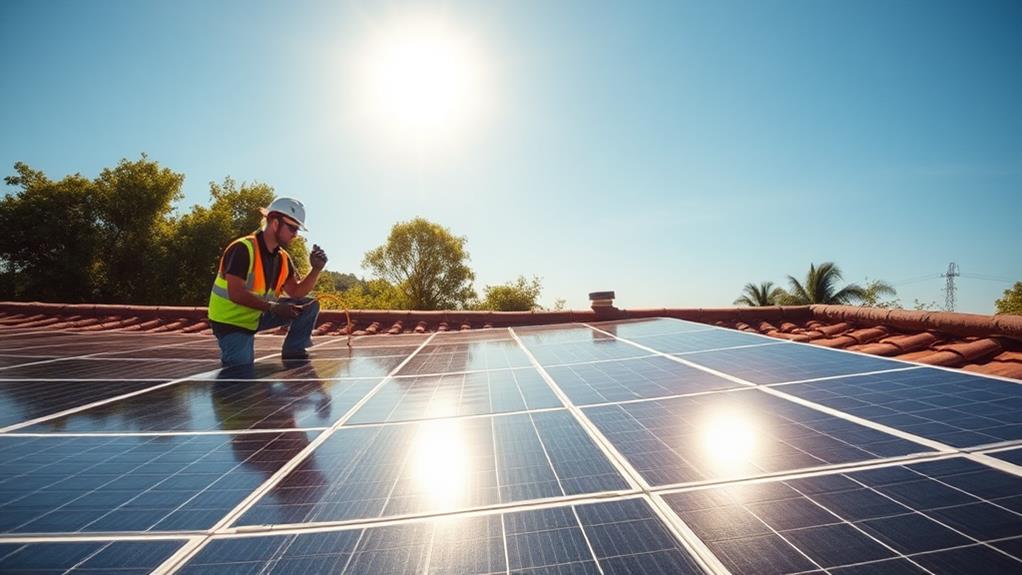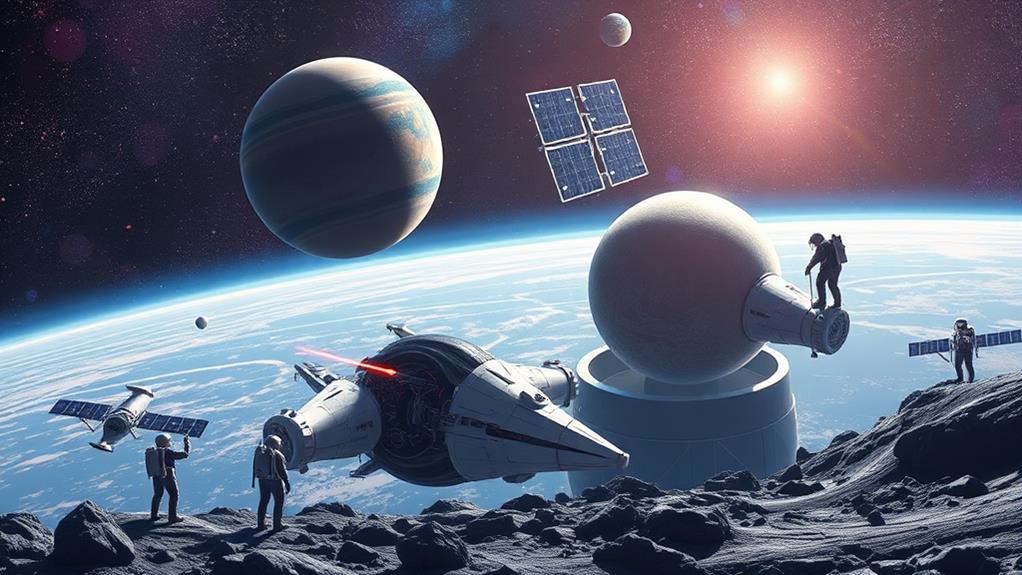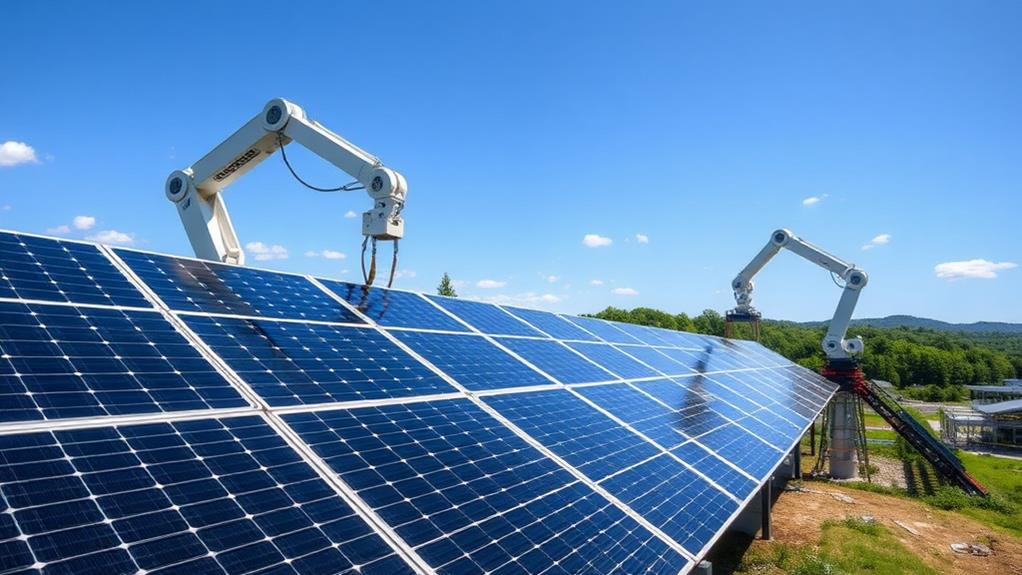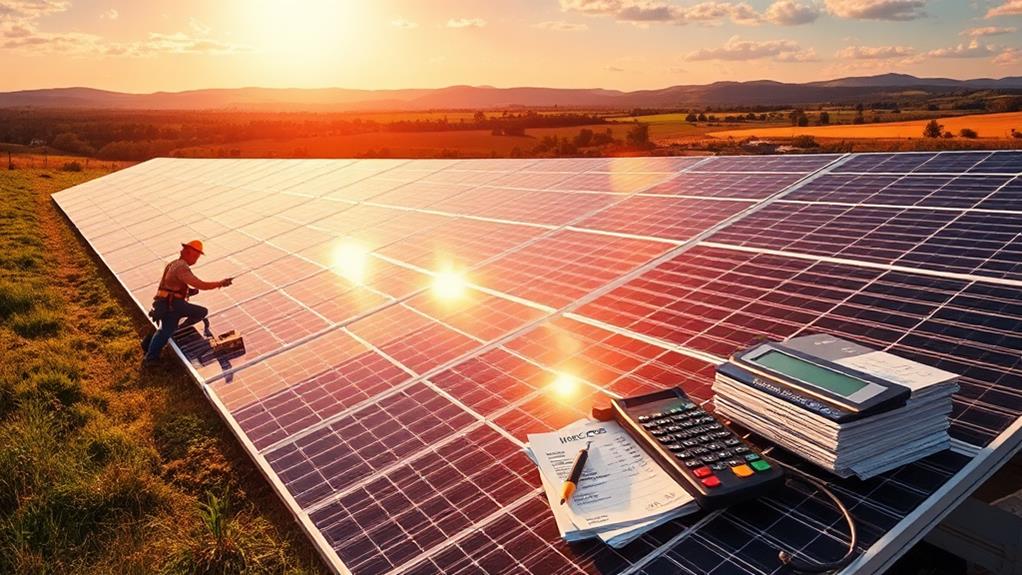To preserve our solar mounting systems at peak efficiency, we need regular cleaning. Use a soft-bristled brush with lukewarm water and avoid abrasives to prevent damage. Inspecting mounting components like brackets and bolts is vital. Tighten loose parts and replace damaged ones. Always monitor system performance with real-time tracking tools for early detection of deviations. Prune surrounding trees to guarantee panels get maximum sunlight. Consider weather impacts and conduct routine inspections. Scheduling professional evaluations and guaranteeing warranty and compliance checks safeguard our investment. Stay informed on the best practices to improve longevity and performance of your system.
Key Takeaways
- Regular cleaning with soft-bristled brushes and lukewarm water reduces solar panel efficiency loss by up to 15%.
- Biannual inspections of brackets and bolts prevent structural weaknesses and ensure proper system function.
- Real-time performance monitoring with specialized tools helps detect energy production deviations and panel malfunctions.
- Pruning surrounding trees and clearing debris maintains optimal sunlight exposure and panel efficiency.
- Routine maintenance and compliance checks validate warranties and extend the solar mounting system's lifespan.
Regular Cleaning Techniques
Maintaining solar mounting systems is essential for optimal performance. Regular cleaning is necessary to ensure our solar panels work efficiently, contributing to a sustainable energy future.
Proper cleaning can reduce efficiency loss by up to 15%, highlighting its importance. Dust and dirt commonly hinder panel performance, which underscores the need for a consistent cleaning schedule.
For those unfamiliar with the process, using the right tools is crucial. A soft-bristled brush or sponge with lukewarm water effectively cleans without damaging the delicate surfaces. It's important to avoid abrasive cleaning products, as they can scratch the panels, reducing sunlight absorption and efficiency.
Taking care of solar panels with the right methods extends their lifespan and impacts energy production positively.
Regular cleaning should be a routine part of solar maintenance. This practice supports the shared goal of embracing renewable energy and fostering a sustainable environment.
Inspecting Mounting Components
After ensuring our solar panels are clean, it's essential to focus on the mounting components that secure the system. Just as a strong foundation is crucial for a building, so is it for our solar arrays. Key parts like brackets and bolts require regular inspection for any damage or wear. Detecting damage involves more than just spotting glaring issues; even a small crack or rust spot can escalate into significant problems.
Loose parts need careful tightening to prevent structural weaknesses that could jeopardise the integrity of the solar array. Should you encounter cracked brackets or corroded bolts, replacing them with durable options such as stainless steel bolts is advisable. This proactive approach maintains the secure fastening of the mounting system, ensuring reliability and efficiency.
Conduct inspections twice a year. These detailed assessments can uncover issues that routine maintenance might miss.
Vigilance helps maintain the safety and efficiency of the solar panels, while also ensuring compliance with warranty requirements. Keep the solar investment robust and dependable.
Monitoring System Performance
Monitoring the performance of our solar system is crucial to optimise energy efficiency and identify potential issues promptly. Observing energy output closely ensures our systems operate at their peak, enhancing our shared commitment to sustainability. Real-time tracking of energy production helps identify deviations from expected performance. This detection is essential, as it allows us to address inefficiencies or potential issues before they escalate.
Specialised tools alert us to possible panel malfunctions or damage. These alerts serve as our system's communication, keeping us informed. Continual monitoring allows us to evaluate our system's efficiency in relation to external factors such as weather or shading. This comprehensive approach helps us understand the performance of our solar panels over time, ensuring we maximise the sun's energy.
Thorough electrical testing of all components ensures everything functions correctly. As a community invested in solar power, we take pride in knowing our systems are optimised and ready to meet our energy needs effectively and reliably. For those seeking high-quality solar panels, the JA Solar 450W Mono PERC Half-Cell Solar Panel comes highly recommended. Its efficiency and durability make it an excellent choice for maximising energy production.
Pruning for Sunlight Access
How can we ensure our solar panels receive optimal sunlight? It's a common concern as we seek peak efficiency and performance from our solar systems. Effective tree trimming is the solution.
Pruning trees near our panels prevents shading during peak sunlight hours, maximising energy production. Trimming overgrown branches allows clear sunlight exposure, which is crucial for enhancing panel efficiency.
Leaves and debris can accumulate around our systems. Regularly clearing these obstructions maintains the top performance of our solar setup. It's about ensuring sunlight has a clear path to our panels, allowing them to function optimally.
Professional consultation for pruning techniques may sometimes be necessary. Professionals bring expertise that enhances sunlight access without damaging trees or property. Efficient vegetation management is vital for consistent solar panel performance. It's a collective effort that contributes to sustainable solar systems.
For those in South Africa, a product like the Ryobi Electric Pole Pruner, available for around ZAR 1,500, can be an excellent tool for efficient trimming. Together, embracing these practices ensures our solar systems remain a sustainable part of our community.
Weather Impact Considerations
Effective tree trimming enhances sunlight access, yet weather impacts on solar panels must also be considered. These panels are crafted to withstand harsh conditions, including hail and hurricanes, thanks to their remarkable wind resistance. While severe weather events can cause occasional damage, the panels' robustness ensures reliability. This durability instils confidence in the systems' ability to endure most storms.
Temperature effects are crucial, as solar panel efficiency drops by approximately 1% for every degree above 25°C (77°F). It's important to be aware of heat-related performance reductions. Elevating panels enhances air circulation, promoting cooling to sustain optimal efficiency on hotter days.
Routine maintenance and inspections are essential. They help identify potential weather-related damage early, ensuring solar mounting systems operate at peak performance. Addressing weather impacts contributes to maintaining equipment and fosters a sense of community and shared responsibility for a sustainable future. Let's remain proactive, ensuring clean energy solutions remain resilient.
For instance, the SolarEdge Inverter, known for its high efficiency and durability, can complement these systems effectively. Regular checks on the inverter's performance can further assure the reliability of the entire setup.
Electrical Testing Procedures
Electrical testing procedures are crucial for ensuring the longevity and efficiency of our solar mounting systems. Our commitment to sustainable energy is reflected in the careful maintenance of these systems. Specialised testing tools allow us to inspect electrical connections and wiring, ensuring optimal performance. These procedures aren't mere routine checks; they're essential for identifying inefficiencies and potential electrical issues before they escalate.
Safety is paramount during these tests. Each step is designed to protect both the equipment and ourselves. Regular electrical testing is a proactive approach to maintaining the functionality and durability of solar panel systems. It enables us to identify problems early and keep everything running efficiently.
Monitoring software or systems further assist in this process. For instance, the SolarEdge Monitoring Platform alerts us to significant declines in energy output. This allows us to ensure all components are operating efficiently. Adhering to these procedures strengthens our commitment to a reliable and sustainable energy future.
Using tools such as the Fluke 1664 FC Multifunction Tester can provide comprehensive testing capabilities. This ensures all necessary checks are thorough and accurate. Such equipment is invaluable for maintaining high standards and ensuring peace of mind.
Scheduling Professional Inspections
To ensure our solar mounting systems operate optimally, professional inspections should be scheduled at least twice a year. This frequency is crucial for maintaining smooth and efficient system performance. Aligning with this schedule not only guarantees peak efficiency but also prolongs the lifespan of our investment. Regular expert evaluations provide opportunities to receive personalised advice on maintenance and necessary repairs.
When technicians assess our systems, they deliver detailed reports offering invaluable insights into the current condition of the solar setup. These reports highlight what's functioning well and what may require attention. Experts also share guidance on effective cleaning techniques and monitoring strategies, enabling us to maintain our systems confidently.
For example, a recommended product for cleaning solar panels is the Karcher WV 5 Premium Window Vac, which effectively removes dirt without scratching the surface.
Additionally, using a monitoring system such as the Solar-Log 50 can help track the system's performance, ensuring timely interventions when needed.
Warranty and Compliance Checks
Understanding the importance of warranty and compliance checks for solar mounting systems is essential. As a community focused on sustainable energy, we know the value of maintaining the integrity and performance of our solar panels. Regular compliance checks are vital to validate warranty cover. Many manufacturers stipulate these inspections to ensure systems remain stable and efficient.
Adhering to compliance requirements safeguards our investment and enhances the longevity of solar systems. Inspections typically involve checking for loose or damaged components within the mounting system. Though it might seem repetitive, such checks are crucial for maintaining warranty cover. Promptly replacing any compromised parts according to the manufacturer's guidelines preserves system efficiency.
Engaging in periodic warranty checks strengthens our connection to the wider community of solar users who value reliability and performance. Meeting these compliance requirements demonstrates dedication to excellence and sustainability. Supporting each other ensures solar mounting systems remain a source of pride and efficiency for years to come.
For instance, the Renusol VS+ mounting system is known for its durability and ease of inspection, making it a recommended choice for those prioritising long-term reliability.
Conclusion
Taking care of our solar mounting systems is crucial for ensuring they work well and last a long time. Regularly cleaning the panels, checking parts, and keeping an eye on how they perform are key steps to keep things running smoothly. It's also important to cut back any plants that might block sunlight and consider how weather conditions affect the system. Conducting electrical tests and scheduling professional inspections helps prevent issues. Staying updated on warranty and compliance checks keeps us informed and protected.
If you have any questions about our Rail-Less Solar Brackets, End Spacers, Structural Brackets, Ground Mounted Solar Systems, Corrugated Brackets, or Earthing Plates, feel free to reach out to us at Deo Solar. We're here to help you with our services, including the DeoSizer Tool, Evaluation and Design, Maintenance and Support, and Solar Installations. Contact us today to keep your solar systems in top shape!

